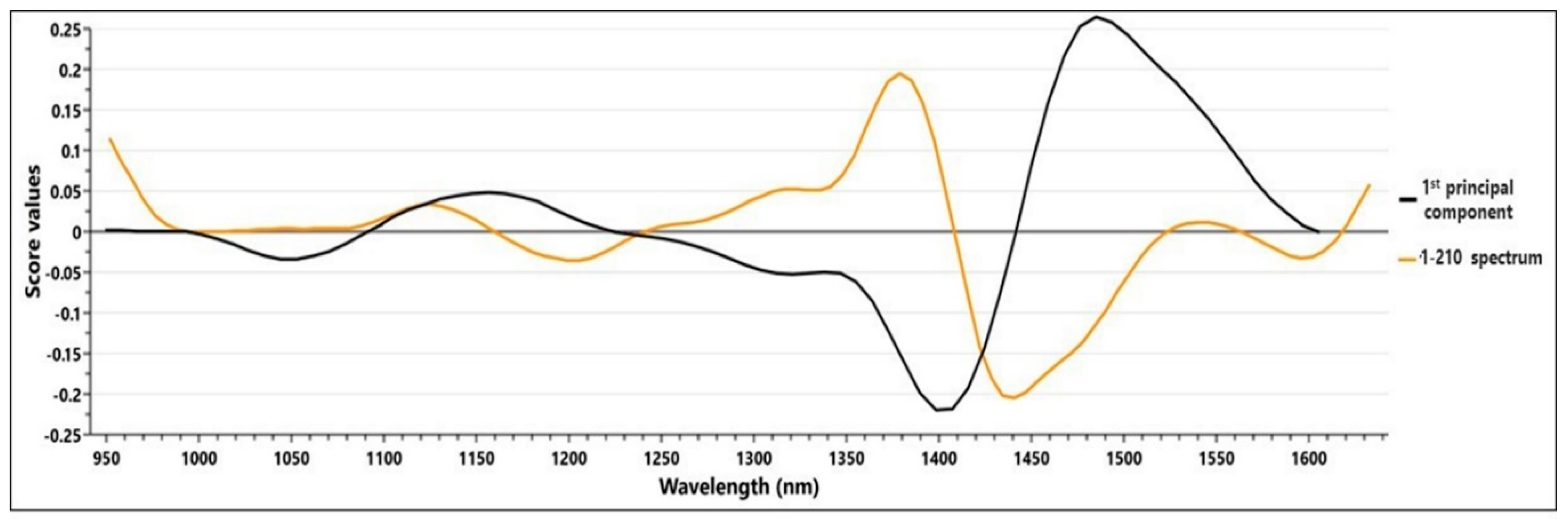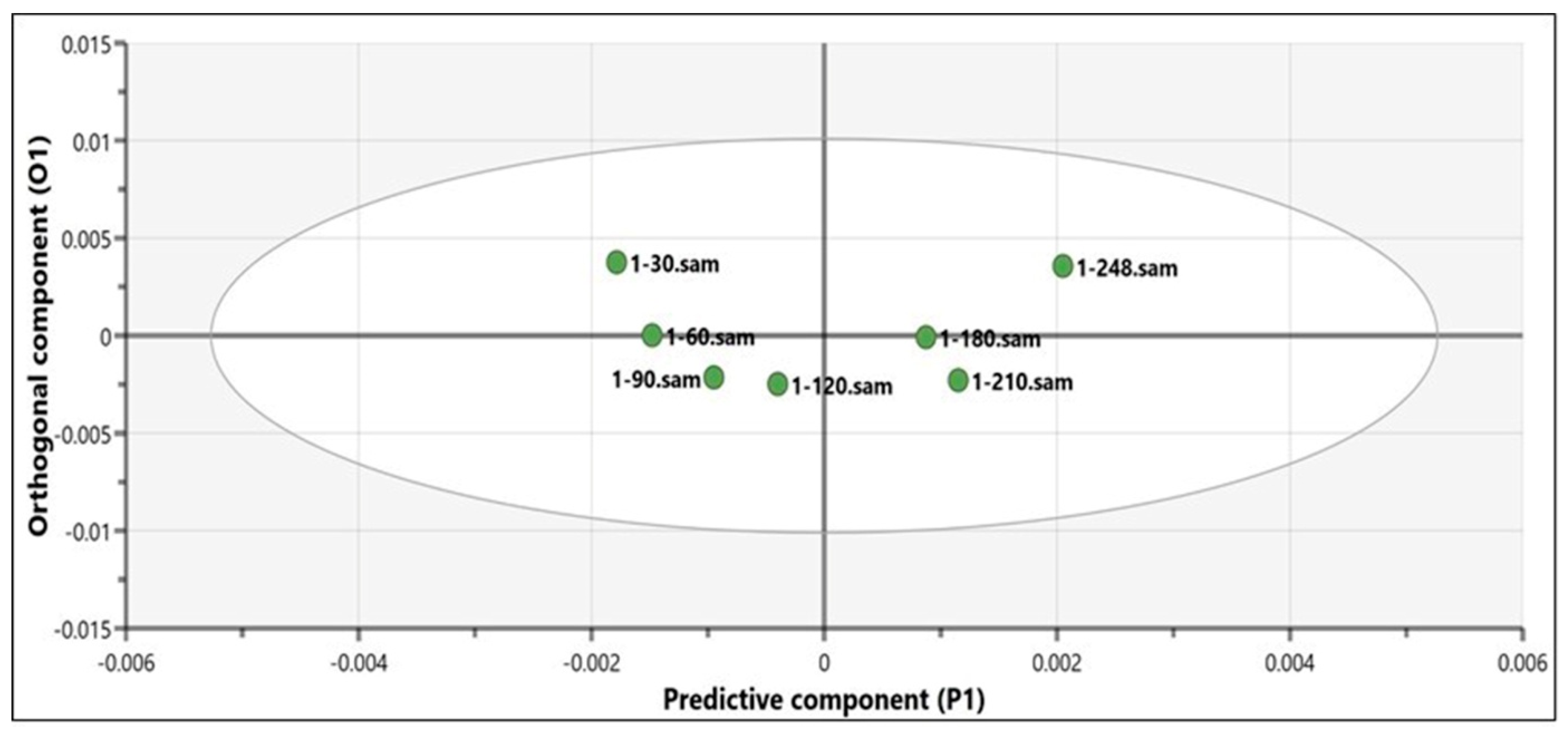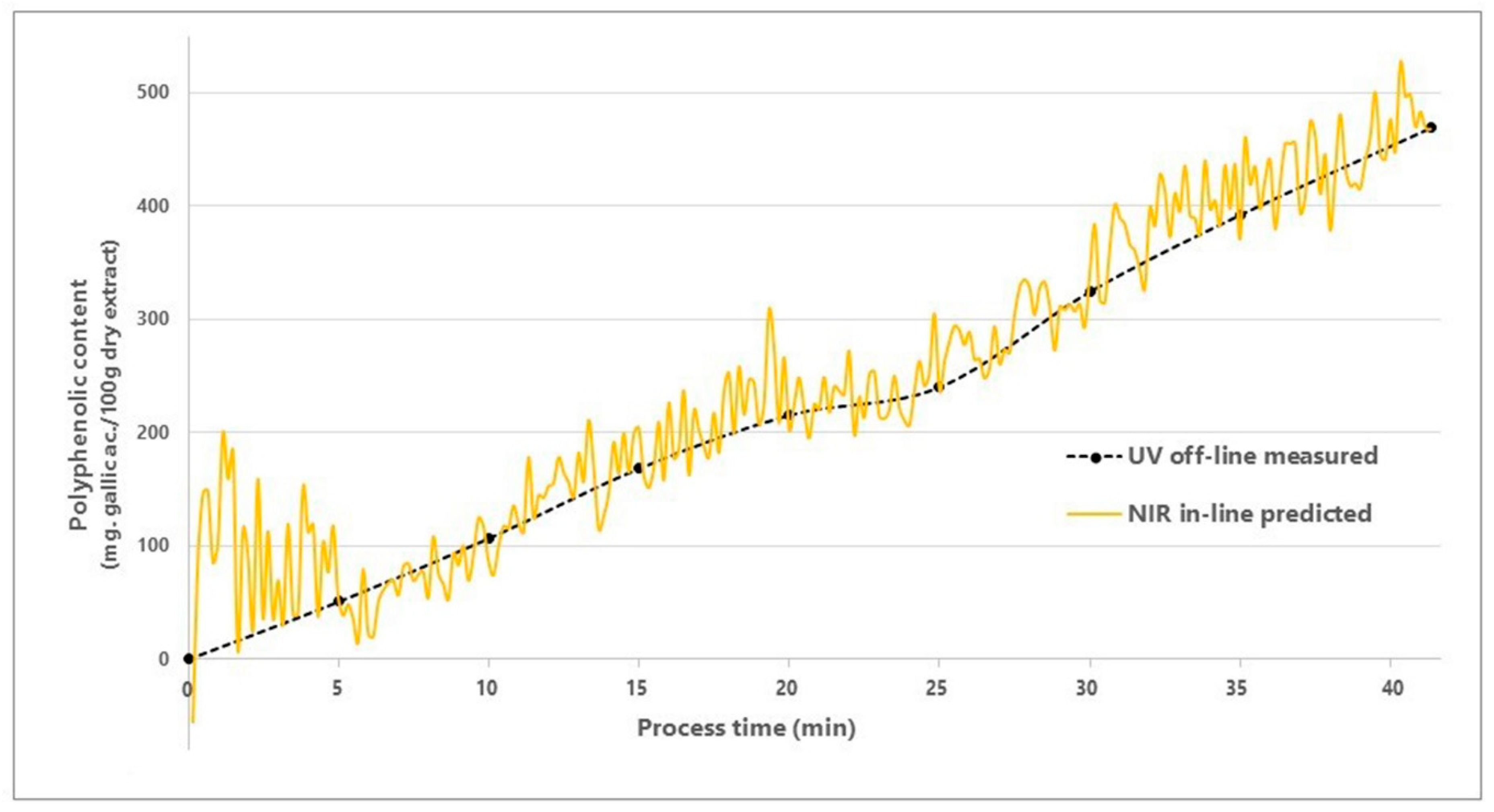Development of a NIR Method for the In-Line Quantification of the Total Polyphenolic Content: A Study Applied on Ajuga genevensis L. Dry Extract Obtained in a Fluid Bed Process
Abstract
1. Introduction
2. Results and Discussion
2.1. Dry Extract Characterization
2.2. NIR Spectra Analysis and Method Development
3. Materials and Methods
3.1. Materials
3.2. Dry Extract Preparation and Characterization
3.3. NIR Process Monitoring
3.4. Spectral Data Analysis
4. Conclusions
Author Contributions
Funding
Conflicts of Interest
References
- Sivanesan, I.; Jeong, B.R. Silicon promotes adventitious shoot regeneration and enhances salinity tolerance of Ajuga multiflora bunge by altering activity of antioxidant enzyme. Sci. World J. 2014, 2014, 521703. [Google Scholar] [CrossRef] [PubMed]
- Park, H.Y.; Kim, D.H.; Sivanesan, I. Micropropagation of Ajuga species: a mini review. Biotechnol. Lett. 2017, 39, 1291–1298. [Google Scholar] [CrossRef] [PubMed]
- Toiu, A.; Vlase, L.; Arsene, A.L.; Vodnar, D.C.; Oniga, I. LC/UV/MS profile of polyphenols, antioxidant and antimicrobial effects of Ajuga genevensis L. extracts. Farmacia 2016, 64, 53–57. [Google Scholar]
- Toiu, A.; Vlase, L.; Gheldiu, A.M.; Vodnar, D.; Oniga, I. Evaluation of the antioxidant and antibacterial potential of bioactive compounds from Ajuga Reptans extracts. Farmacia 2017, 65, 351–355. [Google Scholar]
- Ni, B.; Dong, X.; Fu, J.; Yin, X.; Lin, L.; Xia, Z.; Zhao, Y.; Xue, D.; Yang, C.; Ni, J. Phytochemical and biological properties of ajuga decumbens (labiatae): A review. Trop. J. Pharm. Res. 2015, 14, 1525. [Google Scholar] [CrossRef]
- Sivanesan, I.; Saini, R.K.; Noorzai, R.; Zamany, A.J.; Kim, D.H. In vitro propagation, carotenoid, fatty acid and tocopherol content of Ajuga multiflora Bunge. 3 Biotech 2016, 6, 91. [Google Scholar] [CrossRef] [PubMed]
- Toiu, A.; Mocan, A.; Vlase, L.; Pârvu, A.E.; Vodnar, D.C.; Gheldiu, A.M.; Moldovan, C.; Oniga, I. Phytochemical composition, antioxidant, antimicrobial and in vivo anti-inflammatory activity of traditionally used Romanian Ajuga laxmannii (Murray) Benth. (“nobleman’s beard” - barba împăratului). Front. Pharmacol. 2018, 9, 1–15. [Google Scholar] [CrossRef] [PubMed]
- Ghita, G.; Cioanca, O.; Gille, E.; Necula, R.; Zamfirache, M.M.; Stanescu, U. Contributions to the phytochemical study of some samples of Ajuga reptans L. and Ajuga genevensis L. Bull. Transilv. Univ. Braşov Ser. VI 2011, 4, 7–14. [Google Scholar]
- Muzaffar, K.; Kumar, P. Parameter optimization for spray drying of tamarind pulp using response surface methodology. Powder Technol. 2015, 279, 179–184. [Google Scholar] [CrossRef]
- Patil, V.; Chauhan, A.K.; Singh, R.P. Optimization of the spray-drying process for developing guava powder using response surface methodology. Powder Technol. 2014, 253, 230–236. [Google Scholar] [CrossRef]
- Teixeira, C.C.C.; de Freitas Cabral, T.P.; Tacon, L.A.; Villardi, I.L.; Lanchote, A.D.; Freitas, L.A.P. de Solid state stability of polyphenols from a plant extract after fluid bed atmospheric spray-freeze-drying. Powder Technol. 2017, 319, 494–504. [Google Scholar] [CrossRef]
- Cantor, S.; Augsburger, L.; Hoag, S.; Gerhardt, A. Wet granulation. In Pharmaceutical Dosage Forms: Tablets; Informa Healthcare: New York, NY, USA, 2008; pp. 1932–1944. [Google Scholar]
- Găvan, A.; Toiu, A.M.; Tamaș, M.; Tomuță, I. Dry rose petal extracts and compressed lozenges: Formulation and NIR—Chemometric quantification of active principles. Farmacia 2017, 65, 577–583. [Google Scholar]
- McGoverin, C.M.; Weeranantanaphan, J.; Downey, G.; Manley, M. Review: The Application of near Infrared Spectroscopy to the Measurement of Bioactive Compounds in Food Commodities. J. Near Infrared Spectrosc. 2010, 18, 87–111. [Google Scholar] [CrossRef]
- Mocan, A.; Crișan, G.; Vlase, L.; Crișan, O.; Vodnar, D.; Raita, O.; Gheldiu, A.-M.; Toiu, A.; Oprean, R.; Tilea, I. Comparative Studies on Polyphenolic Composition, Antioxidant and Antimicrobial Activities of Schisandra chinensis Leaves and Fruits. Molecules 2014, 19, 15162–15179. [Google Scholar] [CrossRef] [PubMed]
- Andriamadio, J.H.; Rasoanaivo, L.H.; Benedec, D.; Vlase, L.; Gheldiu, A.-M.; Duma, M.; Toiu, A.; Raharisololalao, A.; Oniga, I. HPLC/MS analysis of polyphenols, antioxidant and antimicrobial activities of Artabotrys hildebrandtii O. Hffm. extracts. Nat. Prod. Res. 2015, 29, 2188–2196. [Google Scholar] [CrossRef] [PubMed]
- Ali, L.; Mabood, F.; Rizvi, T.S.; Rehman, N.U.; Arman, M.; Al-Shidani, S.; Al-Abri, Z.; Hussain, J.; Al-Harrasi, A. Total polyphenols quantification in Acridocarpus orientalis and Moringa peregrina by using NIR spectroscopy coupled with PLS regression. Chem. Data Collect. 2018, 13–14, 104–112. [Google Scholar] [CrossRef]
- Pandey, K.B.; Rizvi, S.I. Plant polyphenols as dietary antioxidants in human health and disease. Oxid. Med. Cell. Longev. 2009, 2, 270–278. [Google Scholar] [CrossRef] [PubMed]
- Berté, K.A.S.; Beux, M.R.; Spada, P.K.W.D.S.; Salvador, M.; Hoffmann-Ribani, R. Chemical Composition and Antioxidant Activity of Yerba-Mate ( Ilex paraguariensis A.St.-Hil., Aquifoliaceae) Extract as Obtained by Spray Drying. J. Agric. Food Chem. 2011, 59, 5523–5527. [Google Scholar] [CrossRef] [PubMed]
- Jacques, R.A.; Santos, J.G.; Dariva, C.; Oliveira, J.V.; Caramão, E.B. GC/MS characterization of mate tea leaves extracts obtained from high-pressure CO2 extraction. J. Supercrit. Fluids 2007, 40, 354–359. [Google Scholar] [CrossRef]
- Gini, T.G.; Jeya Jothi, G. Column chromatography and HPLC analysis of phenolic compounds in the fractions of Salvinia molesta mitchell. Egypt. J. Basic Appl. Sci. 2018. [Google Scholar] [CrossRef]
- Frizon, C.N.T.; Oliveira, G.A.; Perussello, C.A.; Peralta-Zamora, P.G.; Camlofski, A.M.O.; Rossa, Ü.B.; Hoffmann-Ribani, R. Determination of total phenolic compounds in yerba mate (Ilex paraguariensis) combining near infrared spectroscopy (NIR) and multivariate analysis. LWT Food Sci. Technol. 2015, 60, 795–801. [Google Scholar] [CrossRef]
- Liu, R.; Li, L.; Yin, W.; Xu, D.; Zang, H. Near-infrared spectroscopy monitoring and control of the fluidized bed granulation and coating processes—A review. Int. J. Pharm. 2017, 530, 308–315. [Google Scholar] [CrossRef] [PubMed]
- U.S. Department of Health and Human Services; Food and Drug Administration; Center for Drug Evaluation and Research (CDER); Center for Veterinary Medicine (CVM); Office of Regulatory Affairs (ORA); Pharmaceutical CGMPs. FDA Guidance for Industry: PAT—A Framework for Innovative Pharmaceutical, Development, Manufacturing, and Quality Assurance. Food and Drug Administration: Rockville, MD, USA, 2004. Available online: http://www.fda.gov/CDER/guidance/6419fnl.pdf (accessed on September 2004).
- Frake, P.; Greenhalgh, D.; Grierson, S.M.; Hempenstall, J.M.; Rudd, D.R. Process control and end-point determination of a fluid bed granulation by application of near infra-red spectroscopy. Int. J. Pharm. 1997, 151, 75–80. [Google Scholar] [CrossRef]
- Watano, S.; Sato, Y.; Miyanami, K. Scale-Up of Agitation Fluidized Bed Granulation. IV. Scale-Up Theory Based on the Kinetic Energy Similarity. Chem. Pharm. Bull. 1995, 43, 1227–1230. [Google Scholar] [CrossRef]
- Da Silva, C.A.M.; Butzge, J.; Nitz, M.; Taranto, O.P. Monitoring and control of coating and granulation processes in fluidized beds—A review. Adv. Powder Technol. 2014, 25, 195–210. [Google Scholar] [CrossRef]
- Lee, M.J.; Seo, D.Y.; Lee, H.E.; Wang, I.C.; Kim, W.S.; Jeong, M.Y.; Choi, G.J. In line NIR quantification of film thickness on pharmaceutical pellets during a fluid bed coating process. Int. J. Pharm. 2011, 403, 66–72. [Google Scholar] [CrossRef] [PubMed]
- Rizvi, T.S.; Mabood, F.; Ali, L.; Al-Broumi, M.; Al Rabani, H.K.M.; Hussain, J.; Jabeen, F.; Manzoor, S.; Al-Harrasi, A. Application of NIR Spectroscopy Coupled with PLS Regression for Quantification of Total Polyphenol Contents from the Fruit and Aerial Parts of Citrullus colocynthis. Phytochem. Anal. 2018, 29, 16–22. [Google Scholar] [CrossRef] [PubMed]
- Zhan, H.; Fang, J.; Wu, H.; Yang, H.; Li, H.; Wang, Z.; Yang, B.; Tang, L.; Fu, M. Rapid Determination of Total Content of Five Major Anthraquinones in Rhei Radix et Rhizoma by NIR Spectroscopy. Chin. Herb. Med. 2017, 9, 250–257. [Google Scholar] [CrossRef]
- Wang, J.; Wang, Y.; Cheng, J.; Wang, J.; Sun, X.; Sun, S.; Zhang, Z. Enhanced Cross-Category Models for Predicting the Total Polyphenols, Caffeine and Free Amino Acids Contents in Chinese Tea Using NIR Spectroscopy; Elsevier Ltd.: New York, NY, USA, 2018; Volume 96. [Google Scholar]
- Revilla, I.; Vivar-Quintana, A.M.; González-Martín, I.; Escuredo, O.; Seijo, C. The potential of near infrared spectroscopy for determining the phenolic, antioxidant, color and bactericide characteristics of raw propolis. Microchem. J. 2017, 134, 211–217. [Google Scholar] [CrossRef]
- Paul Findlay, W.; Peck, G.R.; Morris, K.R. Determination of fluidized bed granulation end point using near-infrared spectroscopy and phenomenological analysis. J. Pharm. Sci. 2005, 94, 604–612. [Google Scholar] [CrossRef] [PubMed]
- Nieuwmeyer, F.J.S.; Damen, M.; Gerich, A.; Rusmini, F.; van der Voort Maarschalk, K.; Vromans, H. Granule Characterization During Fluid Bed Drying by Development of a Near Infrared Method to Determine Water Content and Median Granule Size. Pharm. Res. 2007, 24, 1854–1861. [Google Scholar] [CrossRef] [PubMed]
- Tomuta, I.; Porfire, A.; Casian, T.; Gavan, A. Multivariate Calibration for the Development of Vibrational Spectroscopic Methods. In Calibration and Validation of Analytical Methods; Stauffer, M., Ed.; IntechOpen: London, UK, 2018; pp. 35–58. [Google Scholar]
- European Directorate for the Quality of Medicines and HealthCare. European Pharmacopoeia; 9.0.; European Directorate for the Quality of Medicines and HealthCare: Strasbourg, France, 2017. [Google Scholar]
- Malegori, C.; Nascimento Marques, E.J.; de Freitas, S.T.; Pimentel, M.F.; Pasquini, C.; Casiraghi, E. Comparing the analytical performances of Micro-NIR and FT-NIR spectrometers in the evaluation of acerola fruit quality, using PLS and SVM regression algorithms. Talanta 2017, 165, 112–116. [Google Scholar] [CrossRef] [PubMed]
- Alcalà, M.; Blanco, M.; Moyano, D.; Broad, N.W.; O’Brien, N.; Friedrich, D.; Pfeifer, F.; Siesler, H.W. Qualitative and Quantitative Pharmaceutical Analysis with a Novel Hand-Held Miniature near Infrared Spectrometer. J. Near Infrared Spectrosc. 2013, 21, 445–457. [Google Scholar] [CrossRef]
- Rohwedder, J.J.R.; Pasquini, C.; Fortes, P.R.; Raimundo, I.M.; Wilk, A.; Mizaikoff, B. iHWG-μNIR: a miniaturised near-infrared gas sensor based on substrate-integrated hollow waveguides coupled to a micro-NIR-spectrophotometer. Analyst 2014, 139, 3572. [Google Scholar] [CrossRef] [PubMed]
- Friedrich, D.M.; Hulse, C.A.; von Gunten, M.; Williamson, E.P.; Pederson, C.G.; O’Brien, N.A. Miniature near-infrared spectrometer for point-of-use chemical analysis. In Photonic Instrumentation Engineering; Soskind, Y.G., Olson, C., Eds.; SPIE: Bellingham, WA, USA, 2014; p. 899203. [Google Scholar]
- Sun, L.; Hsiung, C.; Pederson, C.G.; Zou, P.; Smith, V.; von Gunten, M.; O’Brien, N.A. Pharmaceutical Raw Material Identification Using Miniature Near-Infrared (MicroNIR) Spectroscopy and Supervised Pattern Recognition Using Support Vector Machine. Appl. Spectrosc. 2016, 70, 816–825. [Google Scholar] [CrossRef] [PubMed]
- Eriksson, L.; Byrne, T.; Johansson, E.; Trygg, J.; Vikstrom, C. Multi-and Megavariate Data Analysis. Basic Principles and Applications, 3rd ed.; MKS Umetrics AB: Umea, Sweden, 2013. [Google Scholar]
Sample Availability: Samples of the compounds are not available from the authors. |




| Sample | Spectra | Process Time (Min) | Reference UV-Vis Off-Line Method (mg Gallic Acid/100 g Dry Extract) | NIR-Chemometric In-Line Method (mg Gallic Acid/100 g Dry Extract) | Recovery (%) |
|---|---|---|---|---|---|
| 1 | 30 | 05′ | 50.94 | 54.67 | 107.33 |
| 2 | 60 | 10′ | 106.79 | 86.93 | 81.40 |
| 3 | 90 | 15′ | 168.58 | 184.30 | 109.33 |
| 4 | 120 | 20′ | 215.75 | 203.30 | 94.23 |
| 5 | 150 | 25′ | 240.44 | 237.16 | 98.64 |
| 6 | 180 | 30′ | 324.81 | 340.44 | 104.81 |
| 7 | 210 | 35′ | 392.49 | 370.93 | 94.51 |
| 8 | 248 | 41′ | 469.26 | 468.05 | 99.74 |
© 2018 by the authors. Licensee MDPI, Basel, Switzerland. This article is an open access article distributed under the terms and conditions of the Creative Commons Attribution (CC BY) license (http://creativecommons.org/licenses/by/4.0/).
Share and Cite
Gavan, A.; Colobatiu, L.; Mocan, A.; Toiu, A.; Tomuta, I. Development of a NIR Method for the In-Line Quantification of the Total Polyphenolic Content: A Study Applied on Ajuga genevensis L. Dry Extract Obtained in a Fluid Bed Process. Molecules 2018, 23, 2152. https://doi.org/10.3390/molecules23092152
Gavan A, Colobatiu L, Mocan A, Toiu A, Tomuta I. Development of a NIR Method for the In-Line Quantification of the Total Polyphenolic Content: A Study Applied on Ajuga genevensis L. Dry Extract Obtained in a Fluid Bed Process. Molecules. 2018; 23(9):2152. https://doi.org/10.3390/molecules23092152
Chicago/Turabian StyleGavan, Alexandru, Liora Colobatiu, Andrei Mocan, Anca Toiu, and Ioan Tomuta. 2018. "Development of a NIR Method for the In-Line Quantification of the Total Polyphenolic Content: A Study Applied on Ajuga genevensis L. Dry Extract Obtained in a Fluid Bed Process" Molecules 23, no. 9: 2152. https://doi.org/10.3390/molecules23092152
APA StyleGavan, A., Colobatiu, L., Mocan, A., Toiu, A., & Tomuta, I. (2018). Development of a NIR Method for the In-Line Quantification of the Total Polyphenolic Content: A Study Applied on Ajuga genevensis L. Dry Extract Obtained in a Fluid Bed Process. Molecules, 23(9), 2152. https://doi.org/10.3390/molecules23092152









